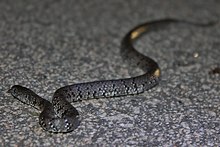Pareidae
| Pareidae | ||||||||||||
|---|---|---|---|---|---|---|---|---|---|---|---|---|

|
||||||||||||
| Systematics | ||||||||||||
|
||||||||||||
| Scientific name | ||||||||||||
| Pareidae | ||||||||||||
| Romer , 1956 |
The Pareidae are a family of small snakes found in northeast India, Southeast Asia, China, Taiwan, and Japan that specialize in capturing snails.
features
The Pareidae are all small to medium-sized, snake-like snakes. The largest species, Aplopeltura boa , reaches a length of 70 to 80 cm. Some of the morphological features of pareatinae are also found in the worm-eating snakes of the viper subfamily xenodontinae and emerged in adapting to these unusual for snakes food convergent in both taxa. In the past, therefore, the species and genera of the Pareatidae were also counted among the Dipsadinae.
The jaws of the Pareidae are short and strong. The teeth are long and narrow, the front part of the maxillary is toothless. The wing legs have no contact with the lower jaw bones and the square leg . A special muscle connected to the salivary gland causes the secretion to be secreted. The hemipenis is forked very deeply, each hemipenis is surrounded by an unusual tissue ring. As with the Dipsadinae, in the Pareatidae it is not the right but the left lung that is reduced, in contrast to the Dipsadinae, however, a rudiment is left of the right one.
Systematics
The Pareidae are one of seven families within the superfamily of the adder and viper-like (Colubroidae). The system of snakes is still the subject of current research. According to Pyron et al. the following system arises within the Colubroidae:
| Adder-like and viper-like |
|
||||||||||||||||||||||||||||||||||||
|
|
There are four genera within the Pareidae family with a total of 23 species:
- Subfamily Pareinae
- Genus Aplopeltura Duméril, 1853
- Short-headed snail ( Aplopeltura boa (Boie, 1828))
- Genus Asthenodipsas Peters, 1864
- Spotted snail snake ( Asthenodipsas laevis (Boie, 1827))
- Asthenodipsas lasgalenensis Loredo, Wood, Quah, Anuar, Greer, Ahmad & Grismer, 2013
- Malay snail snake ( Asthenodipsas malaccanus Peters, 1864)
- Asthenodipsas tropidonotus (Lidth de Jeude, 1923)
- Snails Natter ( Asthenodipsas vertebral (Boulenger, 1900))
- Genus Pareas Wagler, 1830
- Pareas atayal You, Poyarkov & Lin, 2015
- Pareas boulengeri (Angel, 1920)
- Keeled snail snake ( Pareas carinatus (Boie, 1828))
- Pareas chinensis (Barbour, 1912)
- Pareas formosensis (Van Denburgh, 1909)
- Hampton's snail snake ( Pareas hamptoni (Boulenger, 1905))
- Pareas iwasakii (Maki, 1937)
- Pareas komaii (Maki, 1931)
- White-spotted snail ( Pareas margaritophorus (Jan, 1866))
- Pareas monticola (Cantor, 1839)
- Pareas nigriceps Guo & Deng, 2009
- Pareas nuchalis (Boulenger, 1900)
- Pareas stanleyi (Boulenger, 1914)
- Pareas vindumi bird, 2015
- Genus Aplopeltura Duméril, 1853
- Subfamily Xylophiinae
-
Xylophis Beddome, 1878
- Xylophis captaini Gower & Winkler, 2007
- Xylophis perroteti (Duméril & Duméril, 1854)
- Xylophis stenorhynchus (Günther, 1875)
-
Xylophis Beddome, 1878
Individual evidence
- ↑ a b K. Deckert, G. Deckert, GE Freytag, G. Peters, G. Sterba: Urania Tierreich, Fisch, Lurche, Kriechtiere , page 658, Urania-Verlag, 1991, ISBN 3-332-00376-3
- ↑ Hussam Zaher, Felipe Gobbi Grazziotin, John E. Cadle, Robert W. Murphy, Julio Cesar de Moura-Leite, Sandro L. Bonatto: Molecular phylogeny of advanced snakes (Serpentes, Caenophidia) with an emphasis on South American Xenodontines: a revised classification and descriptions of new taxa. Pap. Avulsos Zool. (São Paulo) vol. 49 no.11 São Paulo, 2009, doi : 10.1590 / S0031-10492009001100001 PDF
- ↑ R. Alexander Pyron, Frank T. Burbrink, Guarino R. Colli, Adrian Nieto Montes de Oca, Laurie J. Vitt, Caitlin A. Kuczynski and John J. Wiens: The phylogeny of advanced snakes (Colubroidea), with discovery of a new subfamily and comparison of support methods for likelihood trees . In: Molecular Phylogenetics and Evolution . 2010, p. 329–342 , doi : 10.1016 / j.ympev.2010.11.006 .
- ^ Pareatidae in The Reptile Database
- ^ A b V. Deepak, Sara Ruane and David J. Gower. 2019. A New Subfamily of Fossorial Colubroid Snakes from the Western Ghats of Peninsular India. Journal of Natural History. 52 (45-46) DOI: 10.1080 / 00222933.2018.1557756
- ↑ a b Chung-Wei You, Nikolay A. Poyarkov & Si-Min Lin. 2015. Diversity of the snail-eating snakes Pareas (Serpentes, Pareatidae) from Taiwan. Zoologica scripta. 00: 0-0. DOI: 10.1111 / zsc.12111
